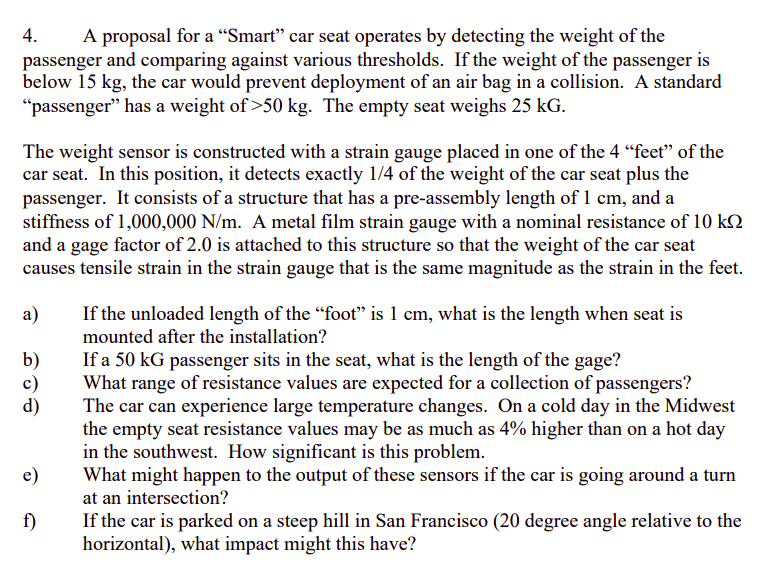4. A proposal for a “Smart" car seat operates by detecting the weight of the passenger and comparing against various thresholds. If the weight of the passenger is below 15 kg, the car would prevent deployment of an air bag in a collision. A standard "passenger" has a weight of >50 kg. The empty seat weighs 25 kG.
4. A proposal for a “Smart" car seat operates by detecting the weight of the passenger and comparing against various thresholds. If the weight of the passenger is below 15 kg, the car would prevent deployment of an air bag in a collision. A standard "passenger" has a weight of >50 kg. The empty seat weighs 25 kG.
Principles of Heat Transfer (Activate Learning with these NEW titles from Engineering!)
8th Edition
ISBN:9781305387102
Author:Kreith, Frank; Manglik, Raj M.
Publisher:Kreith, Frank; Manglik, Raj M.
Chapter1: Basic Modes Of Heat Transfer
Section: Chapter Questions
Problem 1.23P: Using the information in Problem 1.22, estimate the ambient air temperature that could cause...
Related questions
Question

Transcribed Image Text:4.
A proposal for a “Smart" car seat operates by detecting the weight of the
passenger and comparing against various thresholds. If the weight of the passenger is
below 15 kg, the car would prevent deployment of an air bag in a collision. A standard
"passenger" has a weight of >50 kg. The empty seat weighs 25 kG.
The weight sensor is constructed with a strain gauge placed in one of the 4 “feet" of the
car seat. In this position, it detects exactly 1/4 of the weight of the car seat plus the
passenger. It consists of a structure that has a pre-assembly length of 1 cm, and a
stiffness of 1,000,000 N/m. A metal film strain gauge with a nominal resistance of 10 kN
and a gage factor of 2.0 is attached to this structure so that the weight of the car seat
causes tensile strain in the strain gauge that is the same magnitude as the strain in the feet.
a)
If the unloaded length of the "foot" is 1 cm, what is the length when seat is
mounted after the installation?
If a 50 kG passenger sits in the seat, what is the length of the gage?
What range of resistance values are expected for a collection of passengers?
The car can experience large temperature changes. On a cold day in the Midwest
the empty seat resistance values may be as much as 4% higher than on a hot day
in the southwest. How significant is this problem.
What might happen to the output of these sensors if the car is going around a turn
at an intersection?
b)
d)
e)
f)
If the car is parked on a steep hill in San Francisco (20 degree angle relative to the
horizontal), what impact might this have?
Expert Solution
This question has been solved!
Explore an expertly crafted, step-by-step solution for a thorough understanding of key concepts.
This is a popular solution!
Trending now
This is a popular solution!
Step by step
Solved in 3 steps with 1 images

Knowledge Booster
Learn more about
Need a deep-dive on the concept behind this application? Look no further. Learn more about this topic, mechanical-engineering and related others by exploring similar questions and additional content below.Recommended textbooks for you

Principles of Heat Transfer (Activate Learning wi…
Mechanical Engineering
ISBN:
9781305387102
Author:
Kreith, Frank; Manglik, Raj M.
Publisher:
Cengage Learning

Principles of Heat Transfer (Activate Learning wi…
Mechanical Engineering
ISBN:
9781305387102
Author:
Kreith, Frank; Manglik, Raj M.
Publisher:
Cengage Learning